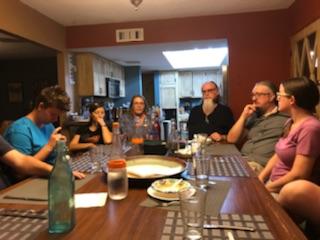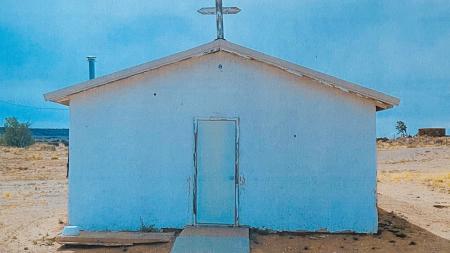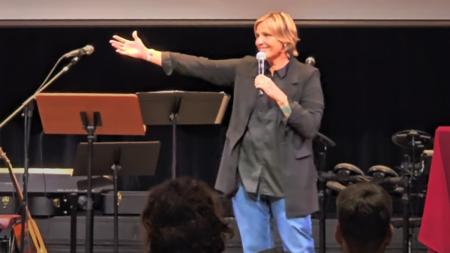The Village Church, Tucson: Helping Heal the Community One Person at a Time

Moses Chung
Rod Hugen and Eric Cepin used the blockbuster 1999 movie The Matrixas part of their template for The Village, the church they founded more than 15 years ago in Tucson, Ariz.
With its cutting-edge special effects and science-fiction action, the movie struck a chord with millions of viewers around the world. But for Hugen and Cepin it was the core message, in an era of falling church attendance and brash skepticism, that hit home.
“We wanted to tap into something about the culture itself, especially about how younger people were feeling — and the movie helped us to do that,” said Cepin, a Christian Reformed Church commissioned pastor.
The venture has been successful. The church, considered an emerging CRC congregation, has been growing slowly, and its approach is resonating with people, especially those born between 1980 and the mid-1990s — millennials. In September the church will begin offering a second service.
The message the founding pastors took from the Oscar-winning movie, starring Keanu Reeves as Neo and Carrie-Anne Moss as Trinity, was that most human beings are trapped and subdued by artificially intelligent machines.
With the help of Trinity, Neo defeats the machines. Afterward, before flying off into space, Neo — who some consider a Christ figure — promises to show people a new world “where anything is possible.”
In the movie, said Hugen, they saw reflected our contemporary culture in which it is easier to live in darkness, without any real faith in God, than to undergo change and be able to live in the light.
“We wanted to reach those people who feel empty and [who sense] that something is not right . . . because in the matrix [portrayed in the movie] people are oblivious,” said Cepin.
“We wanted to reach people who need to find a space where they can be fixed, even if that means things can get raw. We wanted to help people, through the gospel, understand sin as turning away from God” — as basically deciding to stay in the matrix, he said.
Creating a Model for Church
Although the ideas in The Matrix played a role in forming the vision for The Village, the slick cyberworld of the sci-fi film is not particularly evident in the church building.
Begun with the help of funding from Christian Reformed Home Missions, the church is now located on a side street near downtown Tucson. In the sanctuary, you see well-worn couches and easy chairs spread out in front of the area that serves as the pulpit and the table where the Lord’s Supper is served every week. On the wall above the table is a striking desert scene showing three cacti sprouting wings — an image of the Trinity painted by a church member.
To the right is a stage area in which musicians play during worship, using songs composed mainly by church members straight from the Bible. When they play, the music is often in a minor key, which creates sounds of lament and sadness and somber praise as befits a world in which struggle and suffering is too real and common. At the same time, the music has an underlying beauty and reassurance to it.
To the left is the large, open kitchen and dining area. As the regular 5 p.m. Sunday worship goes on, smells from the kitchen drift into the sanctuary from the meal that everyone will eat at long tables or outside after the service.
A key element of every service is reciting the Apostles’ Creed. The children lead the congregation in reciting the Apostles’ Creed one week and in saying the Lord’s Prayer the next.
The sermon at this congregation is always biblically rooted, often full of stories and advice for living and touching others, and at the end the preacher, either Cepin or Hugen or one of the other pastors, will include time for comments and discussion. Sometimes the discussion gets heated, but that is fine.
“People are free to move around during the service,” said Hugen, a commissioned pastor and longtime church planter who once served as president of the board of Christian Reformed Home Missions before it became part of Resonate Global Mission.
“This is a value-oriented church built around accessibility and authenticity. Our vision is to help all people — and many who show up here are hurting deeply — come to God,” said Hugen.
This happens through discipleship, which is more than just telling people the good news; this involves each member seeking to live out the good news and share it with others, added Cepin.
“We teach that sin is turning away from God,” he said. “Along the way, we have learned to help each other walk this experience of life together.”
Becoming Neo-Monastic
Because some 150 adults and young people have been packing the church on Sunday evenings, the church decided, through a process of prayer including all Village members, to add a service on Sunday mornings in mid-September.
While this is necessary to accommodate growth, the church is committed to maintaining one of its defining values as a Neo-Monastic congregation.
Neo-Monasticism is a recent movement including churches of many denominations. It takes on different forms. But normally it is characterized by a communal life expressed in various ways; a focus on hospitality; and intentional, practical engagement with the poor.
“In our case it means that we eat together, worship together, share places to live, and work together in the church, taking turns as janitors, cooks, teachers, nursery attendants, in much the way a monastery operates,” said Hugen. “It is not just worship and Bible study but being deeply involved in each other’s lives.”
Eating and Sharing the Message
On a recent Tuesday evening, a group of church members gathered around the table in the home of Eric and Sue Cepin for a dinner of hot dogs, salad, fruit, and soup. The Cepins have shared their home with others for years.
As people ate their meal, they also took time to talk about their church and how it expresses itself as a Neo-Monastic community.
Layne Crawford, a former teacher now working part-time at the University of Arizona, has been connected to The Village for 14 years — ever since a college roommate suggested she attend. Right off, she was attracted by the questions she found herself asking.
“What do I believe? What do I think? What does Jesus say?” she said. “I’ve learned that the gospel incorporates story and that you ask, ‘How does Jesus’ story apply to your story?’”
She has also learned “to listen with grace as people tell their stories. This is the most powerful thing we can do — to listen with a heart of grace,” she said.
Crawford sees Neo-Monasticism “as a way of being in order for the whole group to be fruitful. Imagine the church and home as always together. At The Village, people want to know you and what your burdens are.”
Ashley Cousineau met her husband, Michael, when she was in law school in Boulder, Colo. He had been attending The Village for several years.
After they got married, even though she hadn’t landed a job, they came here and she has loved it. She now works as an attorney, often representing people who are needy and people in the foster care system.
“We, all of us, vow to be together and stay together,” she said, looking around the table. “This is about God and commitment and love.”
Someone else at the table said that being in community can be hard: “Community is like sandpaper against flesh. Sometimes things hurt, and you realize I’m not always going to come through for you.”
Mark Crawford, Layne’s husband, said he grew up in Tucson but wanted badly to leave. When he received a job offer, he was ready to pack his bags. But he believes God told him in no uncertain way to stay and be part of The Village, where he has been a pastor for six years.
He especially remembers the annual belonging service in which members renew their covenant with the church. “I’m part of a community that at first pursued me because they loved me,” he said.
Kevin Sommitz, a hospice coordinator, went to a Christian school while he was growing up, but he never felt God was there for him. After talking in a bar with a woman he knew who attended The Village, he came to a service.
He was surprised right away by the pastor, Eric, who was wearing a doo-rag over his curly hair, and his wife, Sue, who wore long dreadlocks. Then there was the compelling sermon Eric preached on gender identity. It wasn’t long before he felt safe at The Village — and particularly in the small groups called Pilgrim groups, where he “could let loose and be comfortable.”
Sometimes, he said, he may let loose a little too much in his Pilgrim group, but people go with that, accepting it as part of what the group is there for.
At The Village, they teach how “You are burdened by sin, your own sin, sin around you, and sin in the world. Here we confess our sins and talk about what we are doing and where we need to go,” said Hugen.
The Village welcomes all people, regardless of their state in life, and leads them along. That is their way of helping, said Cepin — as their tagline puts it: “to heal the community one person at a time.”
Playing Isaiah 55 in Minor Chords
As the dinner ended, Sue Cepin, a University of Arizona admissions evaluator and musician at The Village, picked up her guitar and played a song, based on Isaiah 55:1-3, in a minor key, her fingers picking notes that were sad and yet full of life.
In many ways, this song exemplifies the missional aspects of the church:
“Bring your emptiness . . . I will have, I will have, I will have compassion,” she sang.
“Come, all you who are thirsty, come to the waters. . . . Give ear and come to me; listen, that you may live. . . . Come, all you who are thirsty, come to the waters. . . .”


